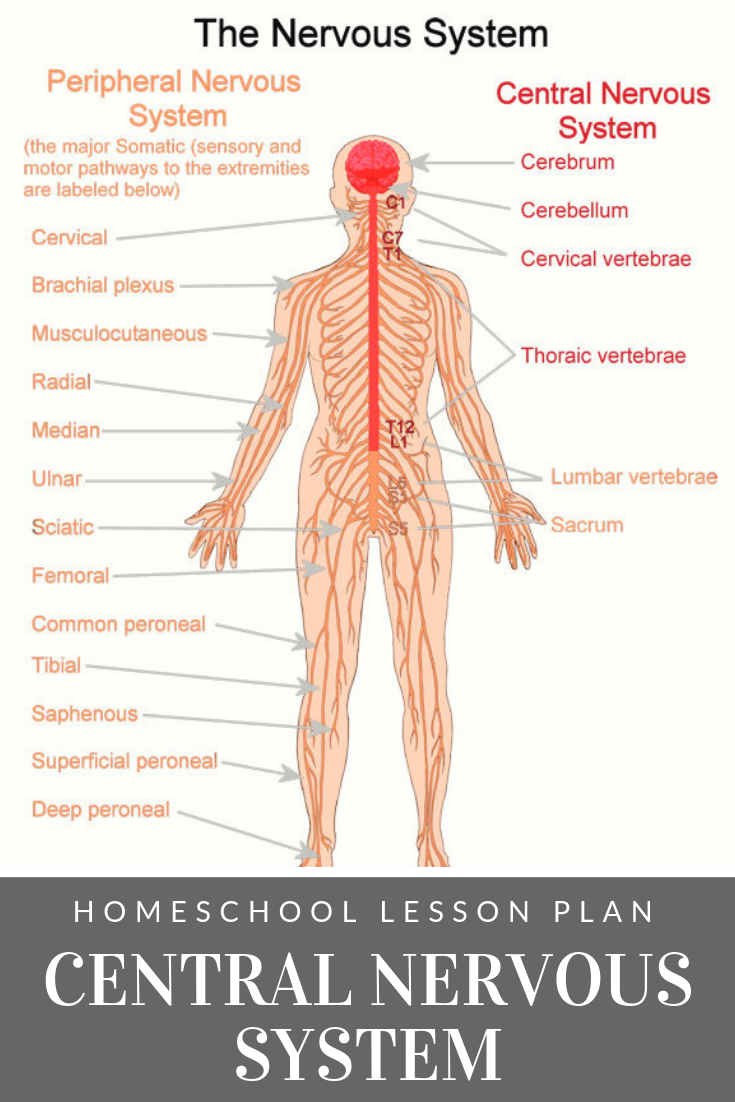The Central Nervous System {Science}
When teaching the Peripheral Nervous System to your children, it is really quite easy to make it fun whilst explaining something that is quite complex. I have put together a Central Nervous System lesson plan and free printable for homeschool students and homeschool moms below that will aide in teaching the Central Nervous System to elementary student.
The Central Nervous System
Lesson Plan
I have the Cental Nervous System Science Lesson Plan as a FREE PRINTABLE in my curriculum store.
You must download and print.
Quote of the Day:
Or do you not know that your body is a temple of the Holy Spirit within you, whom you have from God? You are not your own, for you were bought with a price. So glorify God in your body. 1 Corinthians 6:19-20
“God may forgive your sins, but your nervous system won't” ~ Alfred Korzybski
The Central Nervous System:
The nervous system is a complex system in the body. It has many parts. The nervous system is divided into two main systems, the central nervous system and the peripheral nervous system. The spinal cord and the brain make up the CNS. The main job is to get the information from the body and send out instructions. The peripheral nervous system is made up of all of the nerves and the wiring. This system sends the messages from the brain to the rest of the body.
Your brain is the boss of your body, but it can’t do the job alone. Your nervous system connects the messages from your brain to your body so you can do things like walk, talk, think, feel, and breathe. Your nervous system is the information highway that controls everything you do.
If you think of the brain as a central computer that controls all bodily functions, then the nervous system is like a network that relays messages back and forth from the brain to different parts of the body. It does this via the spinal cord, which runs from the brain down through the back and contains threadlike nerves that branch out to every organ and body part. When a message comes into the brain from anywhere in the body, the brain tells the body how to react.
The human brain is incredibly compact, weighing just 3 pounds. It has many folds and grooves and provide it with the additional surface area necessary for storing all of the body's important information.
Peripheral Nervous System
The spinal cord is a long bundle of nerve tissue about 18 inches long and ¾ inch thick. It extends from the lower part of the brain down through spine. Along the way, various nerves branch out to the entire body. These make up the peripheral nervous system.
VoCaBulary:
Central Nervous System
Peripheral Nervous System
Endocrine System
spinal cord
cranial nerves
spinal nerves
neurons
dendrite
axon
neurotransmitter
synapse
sensory neuron
motor neuron
sonomatic nervous system
autonomic nervous
pituitary gland
thyroid gland
thymus gland
adrenal glands
pancreas
Try This: Using different colors of clay or dough create a model of the brain and a neuron.
Begin by rolling a long piece of clay into a thin tube. Fold it over and over to form the lumpy, bumpy cerebrum. Next, form the cellebellum and place it under the cerebrum. Finally, form the brainstem and place it under the cerebellum. Make the dendrites and cell body out of one color of clay, and make the axon and the terminals out of another color. Finally, add on a nucleus in a third color.
Be Good to Your Brain
So what can you do for your brain? Plenty.
Eat healthy foods. They contain potassium and calcium, two minerals that are important for the nervous system.
Get a lot of playtime (exercise).
Wear a helmet when you ride your bike or play other sports that require head protection.
Don't drink alcohol, take drugs, or use tobacco.
Use your brain by doing challenging activities, such as puzzles, reading, playing music, making art, or anything else that gives your brain a workout.
The Endocrine System
Endocrine System
Discovering The Nervous System:
Name the three parts of the brain:
What part of a neuron receives information?
What part sends the information on its way?
Where do you find the nucleus in a neuron?
What does a sensory neuron do?
What does a motor neuron do?
What is the sonomatic nervous system?
What is the autonomic nervous system?
What does the endocrine system do?










